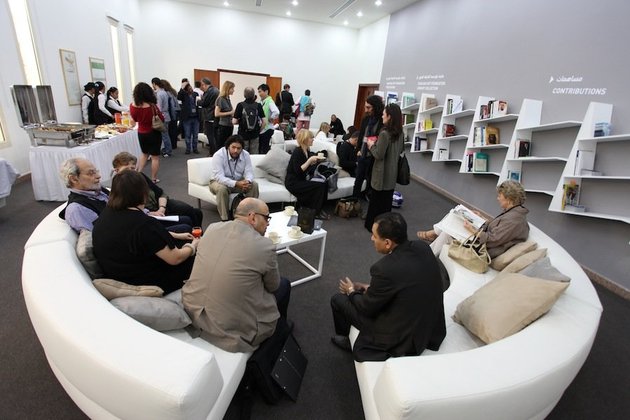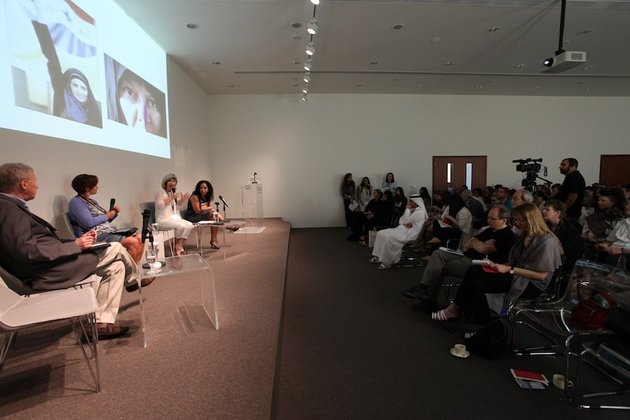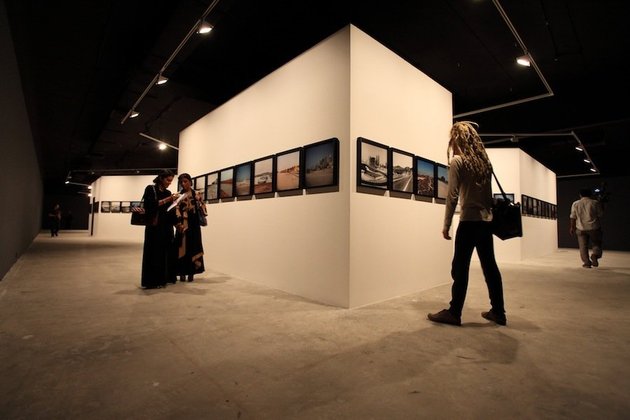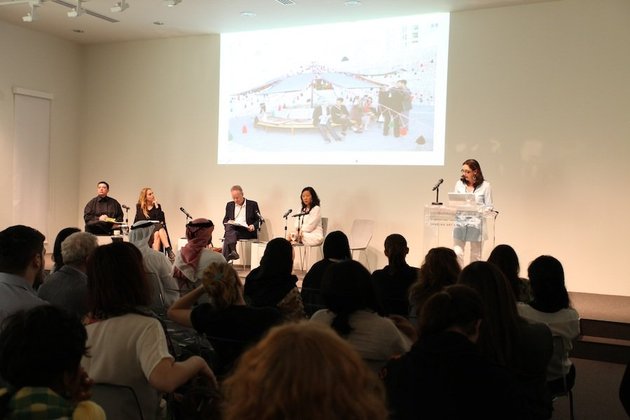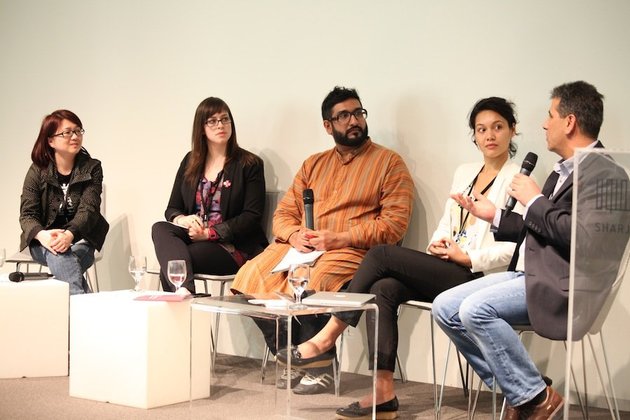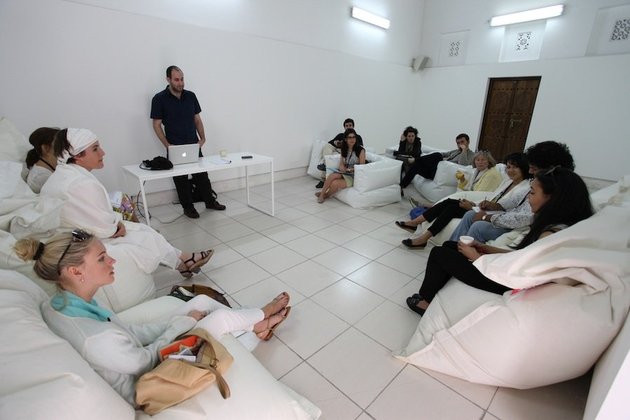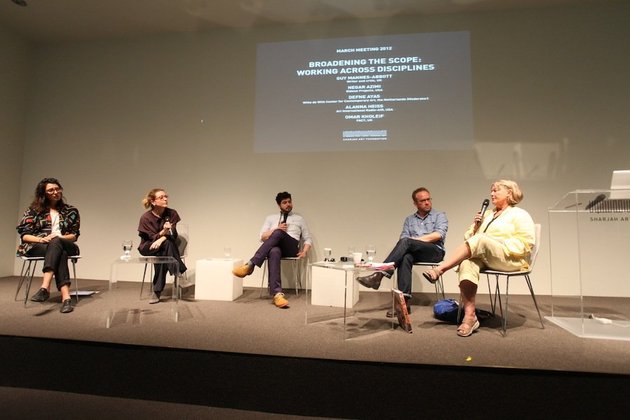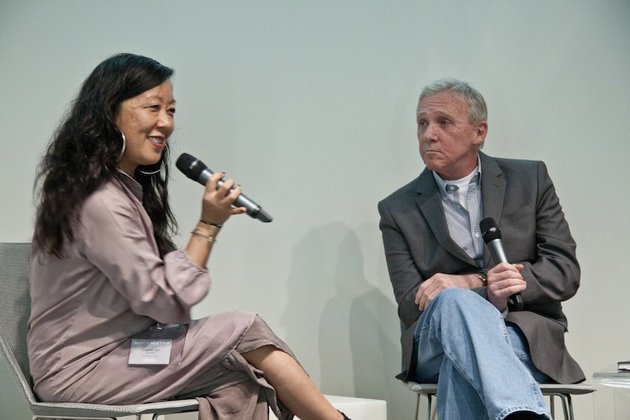News
March Meeting 2012 Report
Sharjah Art Foundation, 17-19 March 2012
The 5th Annual March Meeting, organised by the Sharjah Art Foundation (SAF), chose this year to focus on issues pertaining to residencies and commissions, particularly with regard to artists and audiences, and especially when this takes place in the MENASA (Middle East, North Africa & South Asia) region. In SAF President Sheikha Hoor Al-Qasimi’s opening statement, she summarised the recent explosion of interest in these two strands of contemporary programming, the Foundation’s commitment to hosting artist residencies and supporting the production of new work, and how the Meeting hoped to expand upon and diversify some of the discussions surrounding these two areas. The three-day event saw 80 individuals from across the globe contributing to 11 panel discussions, 16 presentations, four in-conversations and six break-out sessions. It was accompanied by two exhibitions, one performance and the Middle East premiere of a recent film commission.
Day One
The Meeting began with ‘Art and Cultural Diplomacy’, a panel discussion chaired by Dr. Cynthia Schneider, a lecturer in Diplomacy and Culture at Georgetown University. The discussion centred on the role of governmental bodies in initiating and fostering longer-term exchanges and relationships between nations. A lively debate about the true nature of such organisations ensued; Jude Kelly of the Southbank Centre in London was clear that governments have nationalistically-driven (economic/political) agendas and care little about art, and William Wells, Director of Townhouse Gallery in Cairo, offered a sadly humorous and revealing anecdote about the often misguided attempts by foreign embassies to contribute to cultural events – misguided as a result of misunderstandings and stereotyping, false assumptions and misinformation. Artist Sama Alshaibi was brought onto the panel at the last minute – as a replacement for HE Omar Saif Ghobash, UAE Ambassador to Russia, who was detained at the airport – adding a further layer to the discussion with her experiences of working in the region through transnational incentives. The conclusion, shared by many of the panellists, was that cultural diplomacy, if administered by informed individuals and bodies with real connections on the ground, can provide welcome resources (especially in the long term) for the development of more meaningful discussions and outcomes in the creation of opportunities for artists, increased cultural awareness, and the sharing of knowledge across national boundaries.
The second panel of the day was concerned with ‘Commissions and Residencies in the Institutional Context’. Judith Greer, Associate Director of International Programmes for SAF spoke about the Foundation’s commitment to both commissions and residencies for artists. Exhibited in parallel to the March Meeting were three such projects that evidenced this impulse: Ziad Antar’s Portrait of a Territory, a poetic framing of the shores of several emirates from 2004 through 2011, comprising identically-framed and sized photographs taken by the artist over a seven-year period; Tarek Atoui’s collaborative sound project Revisiting Tarab, which culminated in a performance on the final day of the Meeting; and Basma Alsharif’s beautiful and quietly disorienting film installation Farther than the Eye Can See, all produced (or completed) during SAF residencies. Hans Ulrich Obrist discussed a selection of projects initiated in his role as Co-Director of the Serpentine Gallery in London, such as the annual Serpentine Pavilion, and his career-long obsession with fulfilling artists’ dreams, as an inspirational way of thinking about commissions. The Museum as Hub initiative was described with great energy by Eungie Joo, the Keith Haring Director and Curator of Education and Public Programs at the New Museum, who detailed a number of artist, curator and exhibition commissions and exchanges between the project’s partners in Cairo, Seoul, Mexico City, Eindhoven and New York. Beatrix Ruf, Director/Curator of the Kunsthalle Zurich, spoke about the theme in curatorial terms, from the perspective of her institution, while KW Institute for Contemporary Art, Berlin Curator Susanne Pfeffer presented a number of commissions and emphasised the importance of freedom, transparency, trust and duration to engendering successful partnerships between her institution and the artists she has worked with. This was a sentiment shared by all of the panellists and became a recurring theme throughout the Meeting.
The third panel of the day, ‘Minding the Gap: The Critical Role of Smaller Organisations’ was one I participated in, speaking about MASS Alexandria, a two-year-old independent studio and study programme for artists in Egypt, at which I am Programme Coordinator and Associate Curator. This panel included presentations from initiatives taking place in very different circumstances and with diverse approaches and outcomes but that shared a similar organisational and philosophical structure. Moderated by ArtSchool Palestine’s Samar Martha, the audience saw presentations by Latitudes’ Max Andrews and Mariana Cánepa Luna, which explained their beginnings seven years ago and how they have continued to work amid funding shortages and often while juggling many projects simultaneously. Hu Fang’s Vitamin Creative Space in China took a completely different format, as an independent art space and commercial gallery, which seeks to simultaneously confront presumptions about the supposed juncture between the independent and commercial while providing a much-needed funding stream for the space. The panellists, operating in different contexts, each welcomed the flexibility, intimacy and urgency afforded by working on a smaller scale.
The artist Anri Sala, whose latest work 1395 Days Without Red had its Middle East premiere the same day, held a conversation with curator Christine Macel that considered the conceptual aspects of his practice, and how his latest project, a collaboration with Šejla Kamerić and commissioned by Artangel, came into being. Artangel’s Co-Director James Lingwood would later present a diverse portrait of the organisation’s commissions: from the most ephemeral to the longest-term, the most divisive (in terms of public reception) to the most popular. Shezad Dawood, in the vein of artists relaying their experiences of working through a residency or commission, spoke animatedly about his ongoing project Towards the Possible Film. This takes in several landscapes, moments in history, narratives and ideas, from time/space travel to ancient cultures, and has so far relied on the support of various commissioning and residency foundations, and for which continued support is necessary for its completion and distribution.
Day Two
On the second day of the Meeting, independent curator Yasmina Reggad presented ‘Introducing /A.R.I.A./ Artist Residency in Algiers’, an exciting and pioneering new initiative founded by Algerian artist Zineb Sedira, and coordinated by Reggad, to create residency opportunities for international artists in Algiers for varying periods. /A.R.I.A./ is a unique programme in the context of Algeria, and through research and production carried out while in residence, aims to build a culture of exchange that has the potential to develop alternative perceptions of the contemporary art scene in Algeria.
In the late morning, a panel discussion was dedicated to considering ‘Artists and Audiences’ from the perspectives of four different organisations. Moderated by writer, art historian and ‘sometime curator’, Murtaza Vali, it assembled an assortment of voices including Abed Al Ju’beh, Director of The Khalil Sakakini Cultural Centre in Ramallah, which aims to produce, disseminate and archive visual arts in Palestine. Michelle Dezember, Head of Education at the three-year old Mathaf: Arab Museum of Modern art in Qatar, described how educational projects aimed to bridge the gap between audiences and artists, encouraging new levels of engagement with the museum’s programme and opening discussions about art and culture to wider audiences. From MoCA Taipei, Louise Hui-Juan Hsu described specific projects where direct participation from members of the public formed the basis of artists' projects at the museum. Amal Khalaf, Assistant Curator at the Serpentine Gallery’s Edgware Road Project, spoke about the types of audiences and communities that the project engages with, and how they differ demographically from the audience of its mother organisation. Its situation in the Edgware Road area of London offers specific opportunities for encounters with diverse communities in its itinerant space, as well as in coffee shops, shisha bars, restaurants and schools. The nature of its events, exhibitions and workshops reflect and are informed by these communities and have lead to some unexpected, sometimes confrontational but always enlightening encounters between artists and audiences.
In the first of two break-out sessions programmed during the March Meeting, I attended artist Joe Namy’s workshop ‘Pinches: Autonomous Amplifications in Sound/Art’. This cross-disciplinary artist based in America and Lebanon, and currently taking part in Ashkal Alwan’s Home Workspace programme in Beirut, gave a compacted history of sound art experimentations in Egypt and elsewhere, playing extracts to a reduced audience of around ten people. The informal, open setting allowed space for a meaningful exchange, akin to a studio visit; the audience explained their tentative to informed interests in sound, and the artist responded with an erudition tied into his artistic practice.
The following panel discussion titled ‘Artist as Nomad’ invited four artists to consider their various experiences of producing work and taking part in residencies. Ziad Antar told of how he relishes the physical impact his nomadic lifestyle has on his work, describing how airport scanners alter the colour and tone of his film negatives. Šejla Kamerić praised the freedom afforded by the year-long residency she undertook at DAAD in Berlin and Nikolaj Bendix Skyum Larsen was grateful to the prolonged residency opportunities offered by SAF. The panel agreed that trust and transparency were key elements for a mutually beneficial residency, while arguing for the provision of better resources, support and longer periods of stay.
Adeela Suleman, Coordinator of Vasl Artists’ Collective, an independent, artist-run residency programme in Karachi, spoke with Didem Ozbek, Co-Director of PiST, International Project Space, in Istanbul, each describing the importance of encouraging international collaboration through residencies in their respective spaces. Both described their difficulties in running such ambitious programmes with little funding, and as practicing artists. Multi-tasking and flexible programming emerged through their conversation as important qualities for sustaining their exciting, grass-roots projects.
‘Broadening the Scope: Working across Disciplines’ set out to examine ‘interdisciplinarity’ across cultural organisations. Moderated by Defne Ayas, Director of Witte de With in Rotterdam, it included a presentation from writer Guy Mannes-Abbott about his literary project In Ramallah, Running, produced with the support of ArtSchool Palestine and SAF; Alanna Heiss describing her interdisciplinary work at her latest venture Art International Radio, USA; Negar Azimi, Senior Editor at Bidoun Projects giving an illuminating lecture on the different strands of Bidoun and more specifically on its latest issue, produced in residence at the Townhouse Gallery in Cairo in reaction to the ‘Arab Spring’ and the dubious narratives in circulation and heightened interest in the region as a result; and writer and Curator at FACT, Liverpool, Omar Kholeif, speaking about a number of projects engaged with the idea of an interdisciplinary approach. The ensuing debate found that perhaps it wasn’t ‘interdisciplinarity’ that they were trying to discuss, but more simply culture, welcoming and providing a platform for projects that take place in one or more cultural fields, and how the art world is more inclusive when it comes to this than say, platforms for literature or theatre. Kholeif also made the case for a more open approach within the Meeting, where modern technologies such as twitter could have been utilised in order to create a real-time, and legacy, of debate and discussion between those present and absent.
Day Three
The final day of March Meeting began with a presentation by Danda Jaroljmek titled ‘Workshops and Residencies: A lifeline for emerging artists in countries without infrastructures to support the visual arts’. She described with urgency the lack of resources for artists and residencies in Kenya, which she witnessed through her work for the Kuona Trust and the Triangle Network. Artist Amira Hanafi presented Artellewa Art Space, a five-year-old non-profit space located in the Ard el Lewa area of Cairo. In ‘Making and Exhibiting Contemporary Art in an Informal Settlement’, she spoke about her work for the project, which offers a place for international residencies and exhibitions in the poverty-stricken neighbourhood. She insists that Ard el Lewa’s purely ‘psychological’ distance from the art centre of Downtown Cairo limits its audience significantly, and the transformation of this is a great concern to the organisation.
In ‘The Biennial as Commissioning Agent’, chaired by Biennial Foundation’s founder Marieke Van Hal, the resounding issues were related to what happens in a location outside of the duration of the biennial? Projects described by Liverpool Biennial’s Paul Domela advocated longer-term initiatives that could engage a community as well as the biennial’s visitors when the flourish of programming ends. The March Meeting and SAF’s residencies were also acknowledged as good examples of maintaining a level of activity and discussion that could help to build audiences and art scenes. Riyas Komu, of the Kochi-Muziris Biennale Foundation, the youngest biennial on the list here, as well as India’s first, and which will have its first iteration this year, described his aspirations alongside some stunning images of abandoned buildings that will be appropriated for exhibitions and other artistic activities.
An open, free-flowing conversation followed this presentation, between Eungie Joo of the New Museum and William Wells of Townhouse Gallery. They spoke with candour about their experiences of working together as partner institutions in The Museum as Hub project, and the curatorial clashes it entailed, but more importantly the spaces opened up for them by the project to engage in curatorial research across four continents and establishing ties between institutions for future development.
In the second break-out session, Talal Afifi and Areej Zarrouq from the Sudan Film Factory spoke passionately about their inspiring project, from its humble workshop-led beginnings to its current aim of not only producing filmmakers but an entire culture of film in Khartoum. Despite impending funding cuts, the Factory has aspirations for a magazine and the renovation of an abandoned cinema, alongside the continuation of workshops that have so far been in high demand.
The March Meeting emphasised the importance of the projects presented, in the region in particular, as vehicles for collaboration, mutual exchange and the development of artistic practices. It was an invaluable opportunity to learn about and connect with individuals and groups working on different levels – sometimes in areas with no existing infrastructure – for the production, presentation, discussion and engagement of contemporary cultural debates. Over the years, March Meeting has embedded itself into the fabric of the SAF, providing a unique and much-needed discursive platform for contemporary art in the region that, I hope, will continue to do so for many years to come.

